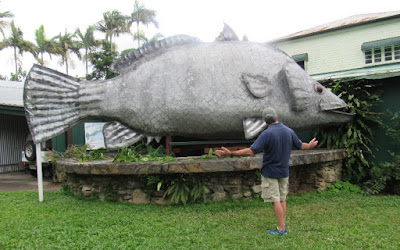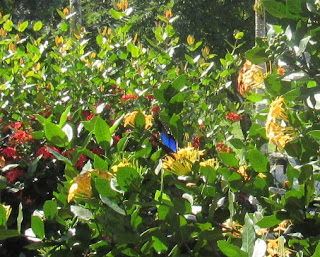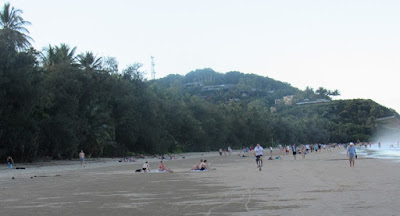While in Port Douglas Robin spent a day sea kayaking with Alex and Paul from Bush and Boat. The expedition left from Cow Bay on the other side of the Daintree River then headed south. Some in the group did the half day tour while Robin and some of the others did the full day tour.
Robin and Beth in a two person kayak.
It was not all hard work - time to relax.
While out on the water they saw sea turtles and porpoises.
They also saw a giant clam.
As well as kayaking the participants spent time learning about land features in the area. At lunch they observed a reef shark swimming close by the beach.
Robin's review of the day is available on Trip Advisor.
Sunday, July 31, 2016
Pork Douglas - Sea kayaking
Port Douglas - Mossman Gorge
Whever we go to Port Douglas we also visit Mossman Gorge, approximately 20 kilometres north west of Port Douglas.
Firstly you drive to the Mossman Gorge Visitor Centre from where you take a shuttle bus to the gorge.
It is then a short walk to a suspension bridge where there is a good view of the water tumbing over the rocks, provided that not too many people, primarily children, are also crossing the bridge.
On the other side is a long circuitous walk through the rainforest.
A wide variety of vegetation can be seen on the walk.
Creeping plants grow on trees.
Moss and lichens grow on rocks, trees and old logs.
Fungi can also grows on trees and logs.
Plants grow on other plants.
Trees develop a variety of root systems.
Large vines also entwine themselves around the trunks of trees.
A great place to explore.
We had lunch at the Mayi Cafe at the Mossman Gorge Visitor Centre where I had a delicious roast vegetable sandwich. We did confuse the staff, however, when I asked for a cup of hot water!
After lunch we looked at art works in the gallery and purchased items from gift shop before returning to Port Douglas.
Firstly you drive to the Mossman Gorge Visitor Centre from where you take a shuttle bus to the gorge.
It is then a short walk to a suspension bridge where there is a good view of the water tumbing over the rocks, provided that not too many people, primarily children, are also crossing the bridge.
On the other side is a long circuitous walk through the rainforest.
A wide variety of vegetation can be seen on the walk.
Creeping plants grow on trees.
Moss and lichens grow on rocks, trees and old logs.
Fungi can also grows on trees and logs.
Plants grow on other plants.
Trees develop a variety of root systems.
Large vines also entwine themselves around the trunks of trees.
A great place to explore.
We had lunch at the Mayi Cafe at the Mossman Gorge Visitor Centre where I had a delicious roast vegetable sandwich. We did confuse the staff, however, when I asked for a cup of hot water!
After lunch we looked at art works in the gallery and purchased items from gift shop before returning to Port Douglas.
Port Douglas - Daintree Village
A short drive north from Port Douglas is Daintree Village situated on the Daintree River.
This is another beautiful location in Far North Queensland, even when it is raining.
The crocodiles also like this area so warning signs are prominently displayed.
On our last visit to Daintree Village we took one of the tours exploring the river and looking for crocodiles.
Once the edge of the Daintree Rainforest before timber cutters removed many of the trees, this is now a farming area.
The cattle grazing in the paddocks are accompanied by cattle egrets.
The slope from the town to the river is steep as can be shown by these flood water markers.
On this trip we made two visits to Daintree Village. The first was in the morning on a showery day and the village was very quiet. The following week we visited early in the afternoon and there were more people around.
The Timber Gallery has displays relating to the history of the timber industry in the area as well as items for sale, however we had the impression that the stock was diminishing in quantity.
The Big Barramundi is one of the features of the village.
When visiting Daintree Village, a place to visit is Eliza's Gallery situated in a house opposite the Big Barramundi. On a previous visit we purchased some pottery but this time purchased glass jewellery made on the premises.
We had lunch at the Daintree Village Hotel, at the river end of Stewart Street, where we shared a prawn and avocado roll. We were about to sit down at a table overlooking a row of bushes with brightly coloured flowers when a Ulysses butterfly appeared. On all our visits to Far North Queensland this was the first time I had seen one in the wild.
These butterflies fly very quickly and are difficult to photograph and when they fold up their wings they appear brown.
The Ulysses butterfy was soon joined by a Cairns Birdwing - bright green wings when flying but green, yellow and brown wings when they are folded.
Later in the day, across the road, we also saw a large butterfly with brown wings with white markings.
While we were trying to photograph butterflies we met a man who was trying to photograph this sunbird which was also exploring the bushes and nearby trees. It didn't really want to stay still for photographs either.
Watching these butterflies and the sunbird was definitely one of the highlights of the holiday.
This is another beautiful location in Far North Queensland, even when it is raining.
The crocodiles also like this area so warning signs are prominently displayed.
On our last visit to Daintree Village we took one of the tours exploring the river and looking for crocodiles.
Once the edge of the Daintree Rainforest before timber cutters removed many of the trees, this is now a farming area.
The cattle grazing in the paddocks are accompanied by cattle egrets.
The slope from the town to the river is steep as can be shown by these flood water markers.
On this trip we made two visits to Daintree Village. The first was in the morning on a showery day and the village was very quiet. The following week we visited early in the afternoon and there were more people around.
The Timber Gallery has displays relating to the history of the timber industry in the area as well as items for sale, however we had the impression that the stock was diminishing in quantity.
The Big Barramundi is one of the features of the village.
When visiting Daintree Village, a place to visit is Eliza's Gallery situated in a house opposite the Big Barramundi. On a previous visit we purchased some pottery but this time purchased glass jewellery made on the premises.
We had lunch at the Daintree Village Hotel, at the river end of Stewart Street, where we shared a prawn and avocado roll. We were about to sit down at a table overlooking a row of bushes with brightly coloured flowers when a Ulysses butterfly appeared. On all our visits to Far North Queensland this was the first time I had seen one in the wild.
These butterflies fly very quickly and are difficult to photograph and when they fold up their wings they appear brown.
The Ulysses butterfy was soon joined by a Cairns Birdwing - bright green wings when flying but green, yellow and brown wings when they are folded.
Later in the day, across the road, we also saw a large butterfly with brown wings with white markings.
While we were trying to photograph butterflies we met a man who was trying to photograph this sunbird which was also exploring the bushes and nearby trees. It didn't really want to stay still for photographs either.
Watching these butterflies and the sunbird was definitely one of the highlights of the holiday.
Port Douglas - Four Mile Beach
A short walk down Macrossan Street is Four Mile Beach.
This long stretch of firm sand is ideal for walking and exploring. In July 1932 Charles Kingsford Smith landed his plane, the Southern Cross, on the beach.
People walk, run or cycle along the sand or just sit and enjoy the sunshine.
At the Macrossan Street end of the beach life savers patrol a section of the beach for swimming.
Beach cricket, beach soccer, beach volley ball are only some of the games played on this stretch of sand.
At the far end of the beach, kites are sometimes flown.
Small sailing boats can be launched from the beach
or can be seen sailing by.
Coconut palms border the beach and coconuts can frequently be found near the palms or at the water line.
Not so many people frequent the far end of the beach but this is also a special place.
When the tide is out the beach seems to double in size.
Shells and coral can often be found on the sand at low tide.
Around the curve at the far end of the beach are mangrove swamps to admire from afar. Crocodiles have been seen in this area.
One afternoon we discovered this kookaburra on the sand.
On another occasion we found this sand crocodile.
When the tide goes out crabs create these patterns in the sand.
Photographing the small crabs, however, can be a challenge.
Sunset was approaching when this photograph was taken.
Four Mile Beach is a beautiful place to visit and explore.
This long stretch of firm sand is ideal for walking and exploring. In July 1932 Charles Kingsford Smith landed his plane, the Southern Cross, on the beach.
People walk, run or cycle along the sand or just sit and enjoy the sunshine.
At the Macrossan Street end of the beach life savers patrol a section of the beach for swimming.
Beach cricket, beach soccer, beach volley ball are only some of the games played on this stretch of sand.
At the far end of the beach, kites are sometimes flown.
Small sailing boats can be launched from the beach
or can be seen sailing by.
Coconut palms border the beach and coconuts can frequently be found near the palms or at the water line.
Not so many people frequent the far end of the beach but this is also a special place.
When the tide is out the beach seems to double in size.
Shells and coral can often be found on the sand at low tide.
Around the curve at the far end of the beach are mangrove swamps to admire from afar. Crocodiles have been seen in this area.
One afternoon we discovered this kookaburra on the sand.
On another occasion we found this sand crocodile.
When the tide goes out crabs create these patterns in the sand.
Photographing the small crabs, however, can be a challenge.
Sunset was approaching when this photograph was taken.
Four Mile Beach is a beautiful place to visit and explore.
Subscribe to:
Comments (Atom)



















































